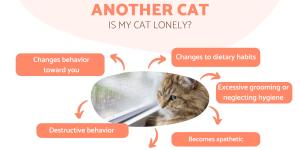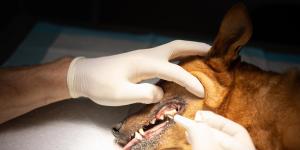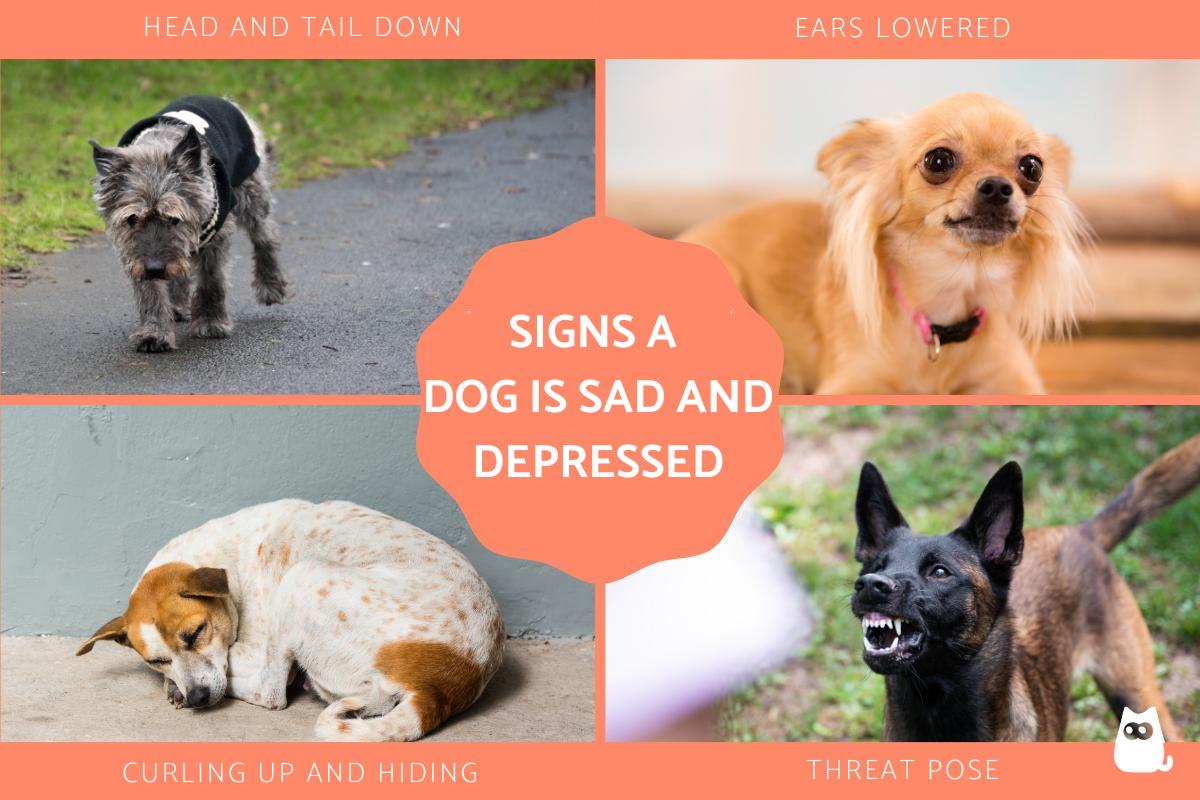Signs a Dog Is Sad and Depressed



See files for Dogs
The signs a dog is sad or depressed are revealed in their body language and behaviors. Dogs do not communicate with us in the same way. They will want to tell us how they are, but they will do so in a manner which requires interpretation on our part. Many people will look at a dog's dace and think they are depressed because of their natural expression. However, facial expressions can be difficult to interpret. What we might think of as sadness in a dog might be contentment or even confusion over our own behaviors. Understanding a dog's body language is vital in forging a happy relationship in the home and ensuring the dog's well-being.
For this reason, AnimalWised shares 10+ signs a dog is sad and depressed. We look at how our dog tries to communicate sadness to us, as well as what we can do to help them.
Why is my dog sad and depressed?
Before we look at the signs and symptoms of depression in dogs, it is important we know why they have reached this negative emotional state. This is easier in some cases than others. Determining the cause of a dog's sadness and depression can be complex, as it could result from various factors. Here are some common reasons why a dog might exhibit signs of sadness or depression:
- Health issues: physical health problems, such as pain or illness, can lead to changes in behavior. If your dog is acting differently, it's essential to rule out any potential health issues through a visit to the veterinarian.
- Changes in routine: dogs thrive on routine. Significant changes, such as a move to a new home, a change in the family structure, or alterations to their daily schedule, can cause stress and sadness. These alterations can be as small as changing to a different feed, but it this is often in conjunction with some other issue.
- Loss of a companion: dogs form strong bonds with their human and animal companions. The loss of a family member, another pet or even a close friend can lead to grief and depression.
- Boredom or lack of stimulation: dogs need mental and physical stimulation. A lack of exercise, play or social interaction can contribute to boredom and sadness. It is also important to know different dogs have different needs. What might be enough stimulation for one dog will be too little for another.
- Separation anxiety: dogs that struggle with being alone may exhibit signs of distress when separated from their owners. Some dog breeds are more prone to separation anxiety than others, but it is usually brought on by other factors such as a lack of affection or insufficient education.
- Environmental changes: changes in the environment, such as a new living space, construction work or loud noises, can cause stress and impact a dog's emotional well-being.
- Traumatic experiences: dogs can be affected by traumatic events, such as accidents or abuse. The emotional impact of such experiences may manifest as sadness or depression.
- Aging: older dogs may experience cognitive decline or medical conditions that affect their mood. This can be seen in other signs of neurological disorders in older dogs.
Different dogs will react to their depression in different ways. This is why it is so important to look at the larger context of the dog's behavior. As will be able to see, the signs a dog is sad and depressed are variable, so getting to know our dog's personality is vital to help gauge their emotional state at any given time.
Learn more about the reasons why a dog's personality changes in our related article.
Lying down for hours
A happy dog is a social and active dog. While there are some factors which can reduce their mobility (such as age and health status), most dogs will want to walk, play or engage with their family at any given opportunity. If a dog is lethargic all the time, but they do not have a specific health problem, it is likely a sign they are sad and depressed.
There are some exceptions for dogs that are naturally not very active. An example are certain brachycephalic dogs which will only be able to perform a limited amount of exercise. Senior dogs will also lose their ability to exercise as much as they did when they were younger, but it does not necessarily mean they are sad.
It is very important we look at the context of the situation. If a dog gradually reduces their activity levels as they age, it does not necessarily mean they are depressed. However, if a young and healthy dog suddenly stops wanting to engage in activities, it is likely something has happened. Since lethargy can also be a symptom of a serious physical health problem, it is vital you take the dog to a veterinarian for a health assessment.

Performing repetitive movements
While we might associate sadness and depression with inactivity, different dogs will respond differently to these emotional states. The body language of a depressed dog can also be energetic, but it will likely be an anxious energy brought upon by stress. These will manifest in something known as ‘stereotypies’. These are repetitive movements which have no specific purpose, but are a sign of sadness in depression in dogs.
While a dog's stereotypy can manifest in almost anything, there are some common stereotypies in dogs. These include:
- Walking around in circles
- Chasing their tail
- Licking metal
- Shaking their legs
- Chewing hair
- Compulsively biting their paws
It is important to remember that some of these stereotypies are not always signs of a sad or depressed dog. They may also be related to certain health issues or are simply natural behaviors. For example, a dog will walk in circles to get comfortable before they lie down or a dog will lick metal if they have a nutritional deficiency. This is why it is so important to look at the context of any dog behavior.
These repetitive behaviors are signs of obsessive compulsive disorder (OCD) in dogs. This is usually related to stressful situations in the home, but can also be related to poor socialization or trauma. They need to be reassured and provided with education to help them deal with stress.

Walking with head and tail down
Although we do not recommend this form of education, you may have scolded your dog and seen them walk away with their head and tail pointed downward. This is known as a calming signal in dogs. It is a form of canine body language which shows they do not want to engage in a fight, so they being submissive to you in the hope they will avoid an altercation.
These calming signals are very useful for dogs in social groups because it can help them to avoid conflict which can lead to physical or emotional damage. However, when a dog is depressed or sad, they may carry out this behavior even when they are not perceiving a threat form another.
In these cases, the dog is usually stressed by something in their environment. Something in the home is making them feel insecure, so they adopt this body language calming signal to try to regain a sense of security. If you regularly scold your dog or if they dog has experienced abuse, it is likely a sign of generalized stress or depression as a result.

Curling up into a ball
Healthy dogs will often curl up into a ball when they want to feel cozy and comfortable. This is a normal behavior and will not necessarily be a sign a dog is sad and depressed. However, if they hide habitually and curl up in fright, then it means there is a serious problem.
There are some cases when a dog will hide and curl up due to pain or illness. When a dog is experiencing a serious illness, they may become confused and scared. By curling up somewhere comfortable, they can help themselves feel protected since there is little else they can do. However, emotional pain can also be the cause of needing to curl up in a place of security.
Learn more about the reasons a dog is hiding and acting strange.

Howling or moaning
Although body language in dogs is the main way canines communicate, this does not mean they do not also use vocalizations. Raising the head to howl or moan is a common sign a dog is sad and depressed. It will usually be at a time when the depression is at an acute stage. In these cases, the dog is likely howling because they want some help. This helps is usually in the form of comfort and reassurance.
As with the other signs a dog is sad and depressed, the context is very important. Some dogs are more vocal then others. They may howl at noises their hear outside, in response to a song or even just to get their guardian's attention. Whether they do it because they are sad and depressed will depend on the other factors in their life. Generally, moaning is a noise which a dog does when they are upset or agitated, but the extent of this can vary greatly.
Also, it is important to note that young dogs may howl for different reasons. When a puppy is howling, it could simply be a process of learning and understanding their canine nature. In the wild, howling is an important form of communication over long distances.

Ears flattened and other calming signals
We have already mentioned some calming signals in dogs, but it is important to know there is a wide range in dog communication. These are a series of body postures and facial expressions which can indicate to another individual what emotion they are feeling in the moment. They show they are uncomfortable with what is happening and they want to deescalate the situation.
Dogs can use calm signals in many situations, but one of the most important is to express a desire for non-interaction. While they do this with other dogs, it is common for a dog to use calming signals with their guardian that they are not in the mood to play or interact in general. Unfortunately, too many guardians do not understand or recognize these calming signals. They can even mistake calming signals as an invitation to play.
Some calming signs that a sad dog or depressed include
- Looking out of the corner of their eye
- Yawning repetitively
- Repetitive licking of the nose or lips
- Lowering their ears
- Avoiding eye contact.
- Licking the guardian's face or hands
A dog licking our hands is one of the most commonly misinterpreted calming signals. This is partly because dogs can use licking as a form of encouragement. The calming signal on its own will not be understood without looking at the broader context of their behavior. Pay close attention to the dog's body language and do not push them if they show resistance.

Tense body posture and other signs of threat
It is essential to understand a dog's body language for many reasons. One of the most important is to help the dog through a difficult time and improve their quality of life. However, it is also important to protect others. When they are sad or depressed, a dog can express these emotions in an aggressive way. When this happens, they will pose a threat. Especially if there are vulnerable persons in the home, this can be a dangerous situation.
Some of the signs a dog is sad and depressed will develop into threats. This is another reason why misinterpreting calming signals is a serious problem. We might think we are having fun with a dog, but they are telling us through their body language that they want to be left alone. If we push, them we can enter an aggressive situation.
Some threat signs in dogs to look out for include:
- Low growls
- Fixed gaze
- Baring teeth
- Marking inappropriately
- Piloerection (raised hairs)
- Tense body posture
There are certain dogs which will resort to aggression more quickly than others. These are dogs that have been poorly socialized, abused, neglected or have not received proper education. If a dog reaches this point, it is essential to work with a professional to help you understand why your dog is sad and to avoid them becoming aggressive.

If you want to read similar articles to Signs a Dog Is Sad and Depressed, we recommend you visit our Basic care category.











